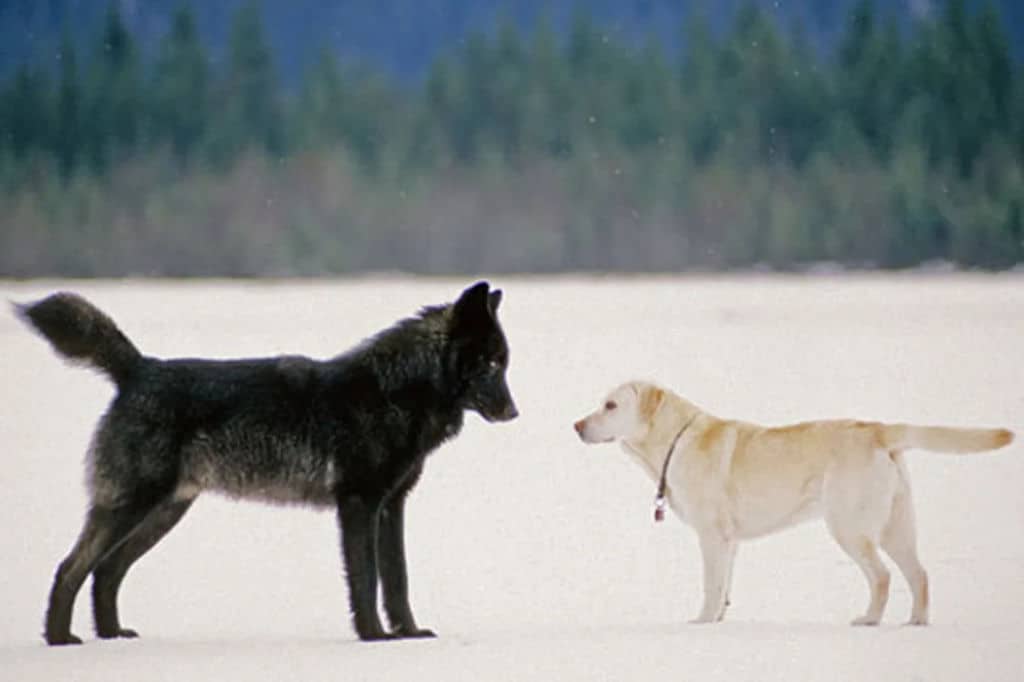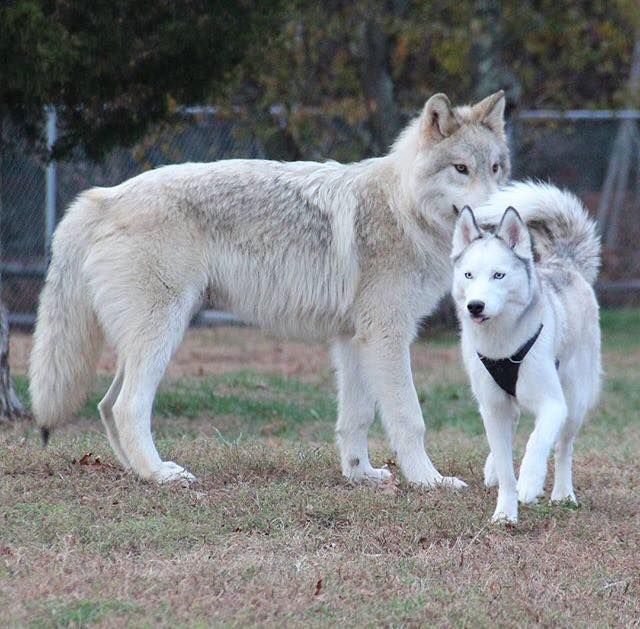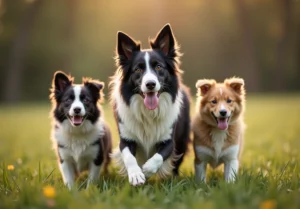While dogs may look like wolves, only a few breeds are genetically close to them. They are very different wild animals, which is why many dogs will avoid them if met in the wild.
According to studies of dogs and wolves interaction, dogs aren’t necessarily scared of wolves but will generally avoid them. There are many videos of dogs either meeting wolves peacefully or running away for their lives, which means the interaction will depend on the situation.
While some dogs may look like wolves, thousands of years of domestication have profoundly altered them. Now, dogs are vastly different from wolves temperamentally and physically.

What Do Dogs Think of Wolves?
Wolves may resemble dogs in paintings and photographs, but they are not the same in real life. They don’t have pointy ears like German shepherds but relatively short, round ears like bears. They also don’t smell like dogs but have the scent of fur rugs. (From Karen Pryor’s book: Reaching the Animal Mind)
Wolves and dogs communicate using similar body language. When both species are ready to play and have fun, they will “play bow” in addition to howling. When they want fun, they chase each other and their tails.
Domestic dogs are well adapted to live with humans, whereas wolves are adapted to living on vast swaths of terrain large enough to support enough prey for them to consume.
In a wolf vs dog comparison, one might observe that while wolves possess the endurance and tenacity honed from survival in the wild, domestic dogs have evolved specific traits advantageous for coexistence with humans.
Wolves are mature when compared to dogs. Wolves don’t ask if something they did was acceptable in your opinion but do so of their own will.
Wolves and dogs freely interbreed, and their pups are as fertile as their parents. Dogs behave the most like young wolves, and the wolves may be tolerant and even befriend dogs. However, they are driven by survival, and nature can be brutal. A dog that approaches a wolf does so at its own risk.
Can a Dog Become a Member of a Wolf Pack? (differences)
What wolves think of dogs has been many times witnessed and investigated. The wolf treats wolf-dogs like they would puppies, whether they are full-blooded or half-bred. They don’t hold them in the same regard as full-blooded wolves in their pack.
Wolves rarely welcome dogs into their pack. Wolf packs are almost often family groupings, and an unrelated wolf would be pushed out. In the case of dogs, it’s even worse.
Dogs are linked to wolves, but it doesn’t mean they act like wolves. People are related to chimps, but that does not mean we are a subspecies of chimps or that we behave like chimps. Barking is rarely heard from experienced, confident adult wolves and is typically produced by juvenile wolves, usually in response to an alarming situation. Barking dogs are frequently scared dogs.
Wolves, relying heavily on non-verbal cues, might interpret a dog’s bark differently, often seeing it as a sign of insecurity or anxiety, rather than a direct challenge.
Because of these reasons, dogs may only be permitted to occupy the lowest level of the wolf pack. They could live a subordinate existence to the wolf, but what’s strange is that the wolves would still feed them like puppies.

While dogs would prefer to be in a pack, wolves would not allow this because these two animals are very different in many regards.
One of the differences between dogs and wolves is the prey drive. Both wolves and dogs have a prey drive, but the wolf’s drive is more dangerous. For prey assaults, dogs usually require a pretty strong stimulus, such as fleeing rabbits or cats. Wolves will attack other dogs and humans without a hint of warning.
On the other hand, dogs have modified their hunting drive to human needs. Their motivation has been focused on herding sheep, hunting with humans, or bringing toys back.
Dogs and wolves are territorial and potentially similar, except that wolves will kill intruders if given a chance. While wolves are superior at living in the wild, dogs win when it comes to living with humans, but they can hardly exist in a pack. In summary, becoming a pack member for a dog is a distant notion.
Which Dog Breed Is Closest to Wolves?
Spitz-type dogs are the most similar to wolves. For example, Japanese Akita and Chow Chow retain wolf-like qualities such as independence, suspicion, and hostility toward new humans and other dogs. When they are puppies, they require extensive training and socializing.
Here’s a graph from an intriguing essay from National Geographic about the origins and evolution of dogs. It reveals which dog breeds have the most wolf-like DNA, with Shiba Inu being the most wolf-like dog breed and Chow chow, Akita, and Alaskan malamute being close behind.

Are Wolves Dangerous to Dogs?
Wolves, like coyotes and sometimes other wolves, may kill dogs under certain conditions. They regard them as competitors, which is why, if you live in wolf country, you should keep your dog leashed and not let it run free. Like dogs are stronger than domestic cats, wolves are stronger than domestic dogs.
In the wild, wolves are exceptionally dangerous to dogs. In a home, it entirely depends on how you treat the wolf and the animal’s character.
If the wolf and dog were kept together, the wolf might act as a protector over the other dog. The only time things could go harmful is if the food is involved.
Wild animals are unpredictable, with no two species acting similarly. It’s unclear if wolves will kill a dog if they come upon one in the wild or merely drive it away.
What Would Happen if a Dog Met a Wolf?
Wolf-dog encounters do not always end pleasantly for the dog. Wolves are territorial, and dogs are similar enough to wolves to cause them to feel the urge to defend their territory. A likely scenario is that the wolf pursues the dog, and if the dog cannot flee, the wolf kills the dog.
Here’s a scenario when a dog escapes a pack of wolves attacking him:
A female in estrus and a male are two possible exceptions. It makes no difference whether the female in heat is a wolf or a dog or if the male is a wolf or a dog. There is enough resemblance that hormones and the instinct to reproduce can lead to mating.
Sometimes, the wolf may ignore the dog. Here’s that scenario in the wild between a hunting dog and a pack of wolves:
In many cases, though, wolves consider coyotes and dogs competitors and will kill them if they do not stay away. If the dog goes into submission mode the moment the wolf enters the range of vision, it may ignore it long enough for the dog to flee, but that is the best-case scenario.
To summarize, if the dog encountered a wolf in the wild, it would be in grave danger and would probably die if it remained. Don’t allow your dogs to run free in predator territory, whether coyotes, wolves, cougars, tigers, or dingoes. You risk losing your dog.
FAQs
Would a wolf kill a dog?
A wolf in the wild might try to attack and kill a dog, especially if the dog comes into contact with a pack of wolves. This is because wolves do not see dogs as equals, and while they occasionally interbreed regarding food, all bets are off. If the wolves are hungry, the dog is in danger.
Do wolves bark like dogs?
The vocalizations of wolves are classified into four types: barking, growling, whimpering, and howling. The wolf’s sounds are a combination of sounds, such as a bark-howl or a growl-bark. When you hear wolves howling in the middle of the night, they are not howling at the moon but communicating.
Alex, a passionate animal lover, has experience in training and understanding animal behavior. As a proud pet parent to two dogs and three cats, he founded AnimalReport.net to share insights from animal experts and expand his knowledge of the animal kingdom.




